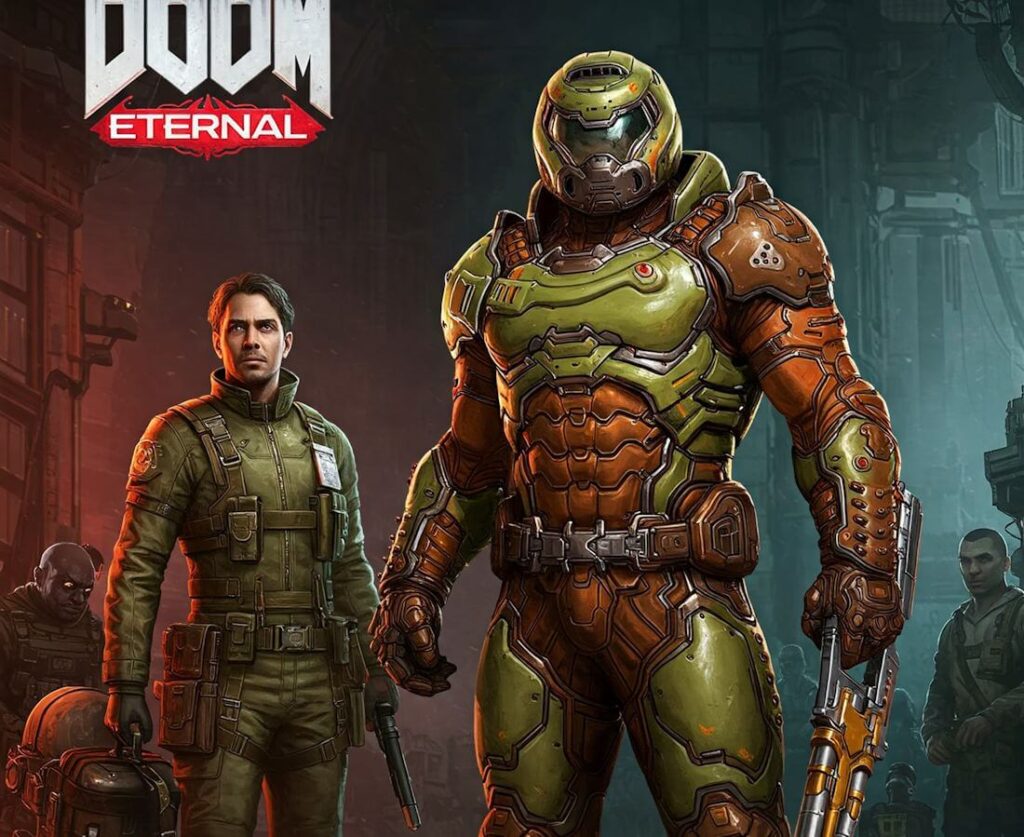Doom Eternal, developed by id Software and published by Bethesda Softworks, was released on March 20, 2020, as the latest installment in the acclaimed Doom franchise. This first-person shooter (FPS) builds upon the foundation established by its predecessor, Doom (2016), while introducing a wealth of new features and mechanics that elevate the gameplay experience. As a direct sequel, Doom Eternal not only retains the high-octane combat and visceral action that fans love but also expands significantly on these elements, making it a noteworthy title in the gaming landscape.
One of the most distinguished aspects of Doom Eternal lies in its fast-paced and fluid combat system. The game encourages players to embrace a dynamic style of play, combining movement with an arsenal of weapons that can be modified to suit various combat scenarios. The introduction of new mechanics, such as the dash ability and the ability to grapple with the Super Shotgun, enhances the player’s mobility and keeps the action intense. Players must constantly change tactics, switch weapons, and utilize their surroundings to outmaneuver a wide array of demonic foes, creating an exhilarating gaming experience.
Furthermore, the game introduces a richly developed narrative that provides context to the relentless action. It delves deeper into the lore of the Doom universe, exploring the conflict between humanity and the forces of Hell, framed within a backdrop of stunning visuals and intricate level design. Additionally, Doom Eternal incorporates new progression systems, allowing players to upgrade their equipment and abilities in meaningful ways. This combination of compelling gameplay, strategic depth, and aesthetic design solidifies Doom Eternal’s significance in evolving the FPS genre, setting a new benchmark for future titles to aspire to.
Innovations in Gameplay Mechanics
Doom Eternal has set a new standard in the first-person shooter (FPS) genre through its introduction of innovative gameplay mechanics that fundamentally alter the player’s approach to combat. One of the most significant advancements is the ‘Push-Forward-Attack’ system. This method encourages players to engage in aggressive tactics rather than defensive play, creating a dynamic that is both exhilarating and rewarding. As a consequence, combat evolves into a fast-paced exchange where players must maintain constant movement and aggressive assault to succeed.
The architecture of Doom Eternal’s gameplay mechanics is designed to promote fluidity and momentum. By incentivizing players to attack rather than retreat, the game reinforces a cycle where offensive strategies become the primary focus. This shift not only enhances the thrill of combat but also integrates seamlessly with the game’s overall design. Players can utilize a variety of weapons and tools tailored for offensive play, including the chainsaw, flamethrower, and the powerful Super Shotgun. Each weapon is crafted to encourage immediate engagement, compelling players to make split-second decisions that can turn the tide of battle.
Additionally, the game introduces resource management mechanics, such as health and ammunition drops from defeated enemies. This feature rewards players for maintaining aggression, as performing well in combat yields essential resources. The necessity to stay aggressive reinforces the mindset that allows players to capitalize on the game’s frenetic pace, pushing them to outmaneuver and overpower their foes.
In summary, the gameplay innovations introduced in Doom Eternal, particularly the ‘Push-Forward-Attack’ approach, revolutionize how players engage with the FPS genre. By fostering an emphasis on offense and continuous action, the game not only redefines combat mechanics but also enhances the overall experience, making it distinctly impactful in the landscape of first-person shooters.
Expanded Movement and Platforming
Doom Eternal has redefined the landscape of first-person shooters (FPS) through its innovative approach to movement and platforming mechanics. The game introduces several new movement options, including dashing, wall climbing, and the use of grappling hooks, which collectively enhance player mobility and enrich the overall gameplay experience. These enhancements allow players to traverse environments with unprecedented fluidity and speed, elevating the intensity and excitement typically associated with the FPS genre.
One notable feature is the dash mechanic, which provides players with the ability to quickly evade attacks and move in multiple directions. This adds a layer of responsiveness during combat situations, enabling players to maintain momentum while dodging enemy fire. The dash not only helps players navigate dangers but also encourages aggressive play styles, as they can close distances to engage enemies or create strategic openings.
Wall climbing further expands the possibilities of movement within the game. By allowing players to scale vertical surfaces, Doom Eternal challenges traditional level design paradigms. This opens up new pathways and encourages exploration, rewarding players who take the time to understand the environment fully. The design encourages a sense of verticality, making levels feel more dynamic and intricate, thereby enhancing the immersive experience.
The grappling hook adds yet another layer of complexity, allowing players to reach high vantage points or traverse gaps quickly. This tool not only facilitates movement but also prompts players to rethink their approach to combat scenarios. By integrating these features, Doom Eternal successfully creates a seamless blend of action and exploration, pushing the boundaries of what players can expect from movement in FPS games.
Overall, the expanded movement options in Doom Eternal have set a new standard for the genre, highlighting the importance of mobility in enhancing gameplay depth and player engagement. The innovations present in this title serve as benchmarks for future FPS releases.
Multiplayer Features and Community Engagement
Doom Eternal has successfully integrated innovative multiplayer features that significantly enhance player engagement and competition within the first-person shooter (FPS) genre. A standout component of these features is the Battlemode, which presents a unique 2v1 player-versus-player experience. In this mode, one player assumes the role of a powerful Slayer, while the other two players take on the mantle of demons, creating a dynamic that tests strategy, skill, and teamwork. This distinct gameplay format not only breaks traditional FPS molds but also encourages players to develop new tactics and approaches.
The introduction of Battlemode fosters a competitive environment, driving players to continuously improve their skills. This engagement is particularly evident through the community interaction; players frequently share strategies, tips, and gameplay sequences, using various platforms to discuss and refine techniques. The multiplayer experience is enhanced through regular updates and seasonal events, ensuring that the player community remains active and invested. Such initiatives also allow developers to gather feedback, fostering a sense of collaboration between the players and the creators.
Moreover, the multiplayer aspects of Doom Eternal contribute significantly to the game’s longevity and replayability, a critical factor in the saturated market of FPS games. Players drawn to competitive gaming will find themselves returning to Battlemode, exploring new strategies and mastering different demons and Slayer abilities. The vitality of these multiplayer features underscores the importance of community in sustaining a game’s relevance over time. The resulting camaraderie between players and the shared experiences in the digital battlefield create a vibrant ecosystem that thrives on competition and collaboration.
Artistic and Audio Design
Doom Eternal is distinguished not only by its fast-paced gameplay but also by its significant advances in artistic and audio design that remarkably enhance the gaming experience. The game’s environments are meticulously crafted, showcasing a diverse and visually stunning array of settings that range from hellish landscapes to alien terrains. Each location is rich in detail, displaying a blend of gothic architecture and industrial design that feeds into the narrative of the game. The use of contrasting colors and dynamic lighting further immerses players, creating an atmosphere that is both captivating and ominous. This attention to artistic detail allows players to traverse environments that feel alive, contributing to a sense of immersion that is vital in a first-person shooter.
Moreover, the design of enemies in Doom Eternal showcases the franchise’s signature aesthetic while introducing innovative new creatures that augment the gameplay experience. Each enemy is not only distinct in appearance but also harmonized with their role within the game mechanics. The variety and intricacy in this design compel players to strategize and adapt their combat approach, enhancing the thrill of each encounter while maintaining engagement throughout the game. The integration of lore through the art of enemy design deepens the narrative and evokes a sense of urgency and excitement.
Complementing the visual aspects, the audio design in Doom Eternal plays a crucial role in shaping its immersive experience. The game features a powerful and iconic soundtrack composed by Mick Gordon, which intensifies the action and heightens emotions during gameplay. The auditory cues provided by varied sound effects not only contribute to the realism of the combat encounters but also guide players throughout the level by signaling the presence of threats or opportunities. Through these artistic choices and meticulous audio engineering, Doom Eternal elevates the FPS genre, creating an unforgettable auditory and visual experience that resonates with gamers long after they put down the controller.
Narrative and World-Building
Doom Eternal sets itself apart in the first-person shooter (FPS) genre through its meticulously crafted narrative and expansive world-building. The game not only continues the legacy of the original Doom titles but also ventures deeper into a rich tapestry of lore that enriches the player experience. Set in a dystopian future where Earth is besieged by demonic forces, the storyline progresses through a series of engaging missions that combine a compelling narrative with immersive gameplay. The balance between storytelling and action keeps players invested in the plot while they engage in fast-paced combat.
One of the standout features of Doom Eternal is its commitment to expanding the Doom lore, providing context and depth to familiar elements. Characters such as the Doom Slayer, who has evolved into a symbol of relentless vengeance against the demon horde, are further developed to showcase their motivations, enhancing the emotional stakes of the journey. The game introduces a plethora of new and returning enemies, each with unique backgrounds and roles that contribute to the overarching narrative, allowing players to dive deeper into the mythology of the series.
The integration of narrative elements with gameplay is seamless, as players progress through visually stunning environments that evoke a sense of foreboding and chaos. Each new location is meticulously designed to not only challenge players’ combat skills but also to reveal snippets of the lore and history of the Doom universe. Collectibles, environmental storytelling, and cutscenes work harmoniously, ensuring players are not just participants in a fight but also unwitting actors in a grander story.
This cohesive blend of narrative and gameplay elevates Doom Eternal beyond a traditional FPS experience, showcasing how a well-developed story can enhance player engagement while navigating intense combat scenarios. The game serves as a benchmark for future titles in the genre, illustrating that deeply integrated narratives can coexist with adrenaline-pumping action, ultimately setting a new standard for storytelling in first-person shooters.
The Impact of Doom Eternal on the FPS Genre
Doom Eternal has significantly reshaped the landscape of the first-person shooter (FPS) genre, setting new benchmarks for gameplay mechanics, narrative pacing, and overall player engagement. By integrating higher speeds and more fluid combat, the game has reinforced the idea that contemporary FPS titles must prioritize dynamic pacing to keep players invested. Unlike many of its predecessors, which often relied on standard combat rhythms, Doom Eternal introduces an exhilarating tempo that keeps players consistently on their toes.
One of the most notable aspects of Doom Eternal is its emphasis on mobility. By allowing players to traverse environments with unprecedented freedom—utilizing wall running, dashing, and grappling—Doom Eternal elevates the genre’s conventions. This focus on player movement encourages a more aggressive approach to combat, where players are rewarded not just for marking targets but for actively engaging with their surroundings. The result is a new paradigm that blurs the lines between shooter action and high-octane platforming elements, challenging future developers to rethink traditional FPS gameplay design.
Furthermore, Doom Eternal revitalizes the concept of interactivity within the game world, leading players to interact with their environment in innovative ways. The game’s mechanics demand resourcefulness, prompting players to juggle combat strategies, environmental elements, and their arsenal effectively. This level of engagement promotes a more immersive experience, wherein players feel a deeper connection to their actions and decisions than ever before.
Future titles within the FPS genre will undoubtedly draw inspiration from Doom Eternal’s groundbreaking advancements. The new standards for pacing, combat fluidity, and player interaction established by this game suggest a transformative trajectory for upcoming shooters. As these trends permeate game design, it is clear that Doom Eternal has not only influenced the current landscape but also laid the groundwork for the evolution of FPS games yet to come.
Comparison with Other FPS Titles
Doom Eternal, released in March 2020, set the stage for a new era in the first-person shooter (FPS) genre, distinguishing itself from contemporaries through its fast-paced gameplay and innovative mechanics. When compared to notable FPS titles from the same period, such as Call of Duty: Modern Warfare and Battlefield V, Doom Eternal showcases a unique blend of strategic combat and relentless action. Unlike Call of Duty, which emphasizes tactical engagements and modern warfare scenarios, Doom Eternal leans heavily into the visceral and frenetic nature of its gameplay, providing players with a distinctive experience that prioritizes speed and agility.
Additionally, titles like Apex Legends and Valorant, which focus on team dynamics and hero-based gameplay, offer contrasting mechanics that cater to different player preferences. Doom Eternal’s single-player campaign, characterized by its elaborate level design and the necessity for quick reflexes, sets it apart from these competitive shooters, which are often rooted in teamwork and strategy. The incorporation of platforming elements and a robust progression system in Doom Eternal enables players to navigate through environments skillfully, thus enhancing engagement and replayability.
An essential factor to consider is the technological advancements introduced in Doom Eternal. Utilizing a refined id Tech 7 engine, the game delivers visually stunning graphics and seamless performance, which enhances the overall gameplay experience. When viewed against previous FPS titles like DOOM (2016) or even older classics such as Half-Life 2, it becomes evident that Doom Eternal pushes boundaries in visual fidelity and environmental interactions. The implementation of mechanics like the dash move, resource management for health and ammo, and the strategic use of weapon mods adds layers of depth not commonly found in traditional FPS games.
In summary, while Doom Eternal shares some features with its FPS peers, its approach to gameplay, innovation, and player engagement firmly establishes its significance within the genre. Its combination of action, strategy, and technological prowess drives home the point that Doom Eternal is not just another FPS title; it is a revolutionary force that continues to influence the landscape of first-person shooters.
Conclusion: The Future of FPS Games
Doom Eternal has undoubtedly set a new standard in the first-person shooter (FPS) genre, merging fast-paced gameplay with complex mechanics and immersive storytelling. The innovations introduced by this title indicate a shift towards a more dynamic and multifaceted gaming experience. As the industry progresses, the influence of Doom Eternal will likely reverberate through the design and execution of upcoming FPS titles. Game developers may take cues from the franchise’s emphasis on fluid movement, strategic resource management, and vibrant visuals, driving them to redefine the benchmarks of action-packed gameplay.
In considering the future of FPS games, it is essential to recognize a potential trend toward an increasingly engaged player experience. The incorporation of more storytelling elements, enhanced character development, and intricate world-building, as evidenced in Doom Eternal, could become the norm. Moreover, the integration of multiplayer features fosters community interaction and competition. As gamers seek both solitary and shared experiences, it is probable that we will witness additional innovations in cooperative gameplay and social interactions within virtual environments.
The evolution of technology and the demand for more realistic simulations also hint at a transformative future for FPS games. Advancements in graphics, artificial intelligence, and virtual reality are poised to enhance immersion levels, allowing players to deeply connect with game narratives and environments. As the FPS genre embraces these emerging technologies, it may expand its boundaries beyond traditional mechanics, fostering new gameplay dynamics that encourage experimentation and exploration.
As with any genre, the essence of creativity and innovation will continue to power the evolution of FPS games. The legacy of Doom Eternal serves as both an inspiration and a framework for what can be achieved within this ever-evolving space, signaling a promising horizon for developers and players alike.



